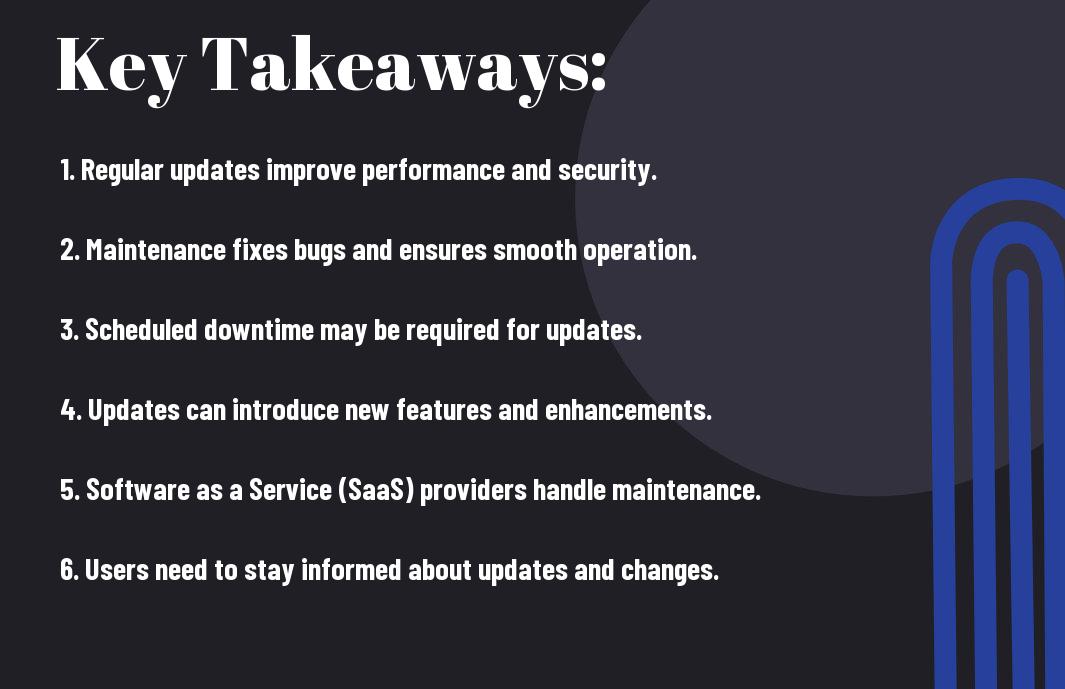Over the years, software services have evolved to become more customizable to meet the unique needs of users like yourself. In this blog post, we probe into the significance of customization in enhancing the effectiveness of software services. By tailoring features to suit your specific requirements, you can optimize efficiency, increase productivity, and ultimately improve your overall user experience. Let’s explore how customization can lead to more personalized and impactful software solutions for you.
Key Takeaways:
- Customization improves user experience: Tailoring software services to meet the specific needs and preferences of individual users can greatly enhance their experience and satisfaction.
- Increased efficiency and productivity: Customization allows users to streamline processes, access relevant information more quickly, and ultimately work more efficiently, leading to increased productivity.
- Competitive advantage: Software services that offer customization options can give businesses a competitive edge by meeting unique customer demands and standing out in a crowded market.


The Rise of Customization
To examine into the topic of customization in software services, it’s crucial to understand the distinction between software configuration and customization. In software development, configuration refers to setting up standard features that are inherent to the software, while customization involves tailoring the software to meet specific user needs. According to a recent article on Configuration vs. Customization: The Right Approach for Your …, finding the optimal balance between these two elements is key to delivering effective software services.
The Shift from One-Size-Fits-All
Any successful software service today acknowledges the shift away from the traditional one-size-fits-all approach. In the past, users were expected to conform to the limitations of off-the-shelf software. However, with the advancements in technology and the increasing demand for personalized experiences, the emphasis has now shifted towards customization. This shift signifies a recognition of the diverse needs and preferences of users, prompting software providers to offer more flexible and tailored solutions.
The Importance of User Experience
Any effective software service prioritizes user experience. Customization plays a vital role in enhancing user experience by allowing individuals to interact with the software in a way that aligns with their unique requirements. When software is tailored to your specific needs, you are more likely to engage with it regularly, leading to increased productivity and satisfaction. Additionally, customizable features empower users to optimize workflows and streamline processes, ultimately improving overall efficiency. OneSizeFitsAll

The Benefits of Customization
Clearly, customization plays a crucial role in the effectiveness of software services. According to Why customization is crucial in software development, customized software solutions are tailored to meet your specific business needs, which can result in various benefits.
Increased Efficiency and Productivity
Increased efficiency and productivity are two significant advantages of customized software services. When software is personalized to align with your workflows and business processes, you can eliminate unnecessary features and streamline operations. This optimization leads to a more efficient use of resources, saving you time and boosting productivity.
Enhanced User Engagement and Satisfaction
One of the key benefits of customization is the enhanced user engagement and satisfaction it brings. Tailoring software to meet the preferences and requirements of your users can significantly improve their experience. When users find the software easy to use and relevant to their needs, they are more likely to engage with it positively, leading to higher satisfaction levels and potentially increased loyalty.
Improved Data Analysis and Insights
One significant advantage of customizing software services is the ability to improve data analysis and derive valuable insights. By customizing your software to collect and analyze data specific to your business processes, you can gain a deeper understanding of your operations. This, in turn, enables you to make more informed decisions and identify areas for improvement.
It is evident that customization not only enhances the effectiveness of software services but also plays a vital role in driving business success by providing tailored solutions to meet your unique requirements.
The Role of Customization in Software Services
Personalized Solutions for Unique Needs
All software services aim to provide solutions to various problems, but not all problems are the same. This is where customization plays a crucial role in ensuring that the software meets your unique needs. By tailoring the software to your specific requirements, you can enhance its effectiveness and efficiency in addressing the challenges you face.
Whether it’s customizing the user interface, adding specific features, or integrating with other tools, personalized solutions can significantly improve your overall experience with the software and empower you to achieve your goals more effectively.
Adaptability and Flexibility in a Rapidly Changing Environment
On top of meeting your current needs, software services must also be adaptable to changes in your environment. In a rapidly evolving landscape, the ability to customize and modify the software to accommodate new requirements or address unforeseen challenges is vital.
Changing market trends, technological advancements, or shifts in your business operations can all impact the way you use the software. By being able to quickly adapt and make necessary adjustments, you can stay ahead of the curve and remain competitive in your industry.
Competitive Advantage in a Crowded Market
Personalized solutions not only cater to your unique needs but also give you a competitive edge in a crowded market. By customizing the software to align with your business processes and objectives, you can differentiate yourself from competitors and offer a more tailored experience to your customers.
The Challenges of Customization
Many software services face challenges when it comes to customization. One of the key challenges is finding the right balance between standardization and flexibility. On one hand, standardization ensures consistency, ease of maintenance, and cost-effectiveness. On the other hand, flexibility allows for customization to meet specific user needs and preferences. Balancing these two aspects is vital to ensure that the software service remains efficient and adaptable to diverse user requirements.
Balancing Standardization and Flexibility
Balancing standardization and flexibility can be a delicate act. Too much standardization can lead to a one-size-fits-all approach that may not fully meet the unique needs of individual users. Conversely, too much flexibility can result in complexity, higher costs, and difficulties in scaling the software service. Striking the right balance requires a deep understanding of user requirements, market trends, and the capabilities of the software service.
Managing Complexity and Scalability
Any customization introduces a level of complexity into the software service. As you tailor the service to specific needs, the number of configurations and options can grow exponentially, potentially making it harder to manage and maintain. At the same time, ensuring that customized features can scale effectively as the user base grows is crucial. Properly managing complexity and scalability involves robust planning, continuous monitoring, and strategic decision-making to optimize performance and usability while accommodating growth and change.
Understanding the interplay between customization, complexity, and scalability is vital for the long-term effectiveness of software services. By carefully managing these factors, you can ensure that your customized software service remains agile, efficient, and sustainable in meeting evolving user demands.
Ensuring Security and Compliance
Any customization in software services must also prioritize security and compliance. As you tailor the service to specific user requirements, there is a risk of inadvertently introducing vulnerabilities or non-compliance with industry regulations. Ensuring security and compliance involves thorough testing, robust protocols, and ongoing monitoring to safeguard user data, protect against cyber threats, and adhere to legal standards.
Managing security and compliance in customized software services requires a proactive approach to risk management and regulatory alignment. By implementing adequate safeguards and staying informed about best practices, you can mitigate potential risks and build trust with your users. Be mindful of, security and compliance are not optional features but vital components of effective software services.
The Future of Customization
Now let’s look ahead at the future of customization in software services. As technology continues to evolve, so too will the ways in which customization plays a role in enhancing the effectiveness of software solutions. In the coming years, we can expect to see a rise in emerging trends and technologies that will further revolutionize the way software services are tailored to meet individual user needs.
Emerging Trends and Technologies
Any software development company that wants to stay ahead of the curve must keep an eye on emerging trends and technologies in the customization realm. From advanced data analytics and personalization algorithms to innovative user interface designs, there are endless possibilities for enhancing the customization capabilities of software services. By staying abreast of these trends, software providers can ensure that they are delivering solutions that are not only cutting-edge but also finely tuned to the unique requirements of their users.
The Potential of Artificial Intelligence and Machine Learning
Learning to harness the power of artificial intelligence (AI) and machine learning (ML) is crucial for the future of customization in software services. These technologies have the potential to revolutionize how software is personalized, providing automated insights into user preferences and behavior that can inform highly tailored experiences. By leveraging AI and ML algorithms, software developers can create dynamic systems that continuously adapt and optimize themselves based on real-time user interactions, ultimately leading to unparalleled levels of customization and user satisfaction.
It is necessary to recognize that AI and ML are not just buzzwords in the tech industry; they have tangible applications that can significantly enhance the customization capabilities of software services. By incorporating these technologies into their development processes, software providers can unlock new levels of personalization and efficiency, ultimately redefining the user experience in profound ways.
The Importance of Human-Centered Design
An necessary aspect of the future of customization in software services lies in the concept of human-centered design. This approach places the user at the forefront of the development process, ensuring that software solutions are not only highly personalized but also intuitive and easy to use. By prioritizing the needs and preferences of the end-user, software developers can create experiences that are not only functional but also emotionally resonant, fostering long-term user loyalty and satisfaction.
To truly excel in customization, software providers must embrace human-centered design principles and strive to create solutions that not only meet the functional requirements of users but also delight and inspire them. By placing the user at the center of the development process, software companies can ensure that their products resonate deeply with their target audience, ultimately driving greater success and differentiation in an increasingly competitive market.
Best Practices for Effective Customization
Collaboration and Communication with Users
One of the best practices for effective customization is ensuring open and consistent collaboration and communication with users. By involving the end-users in the customization process, you can gain valuable insights into their specific needs, preferences, and pain points. This collaboration allows you to tailor the software services to meet the unique requirements of your users, leading to increased satisfaction and usage.
Agile Development and Iterative Testing
Development teams can greatly benefit from following agile practices and conducting iterative testing when customizing software services. Agile methodologies, such as Scrum or Kanban, foster flexibility and responsiveness to changes, enabling you to adapt quickly to user feedback and evolving requirements. Through iterative testing, you can incrementally improve the software services, catching any issues early on and ensuring a smooth customization process.
Communication throughout the customization process is key to successful implementation. Keeping all stakeholders informed and engaged helps streamline decision-making, address any concerns promptly, and maintain alignment on project goals. By fostering clear and transparent communication channels, you can ensure that everyone is on the same page and working towards a common objective.
Continuous Feedback and Improvement
Any effective customization strategy should include mechanisms for collecting continuous feedback and driving ongoing improvement. By gathering feedback from users throughout the customization process, you can identify areas for enhancement and make timely adjustments to optimize the software services. This feedback loop is important for ensuring that the customization meets user expectations and delivers value.
For instance, implementing feedback mechanisms such as surveys, user testing sessions, or feedback forms can provide valuable insights into user satisfaction, usability issues, and feature requests. By leveraging this feedback to drive continuous improvement, you can enhance the overall effectiveness of the customized software services and ensure long-term success.
Conclusion
With this in mind, customization plays a crucial role in the effectiveness of software services. Tailoring software solutions to meet the specific needs and preferences of each individual or business allows for greater efficiency, productivity, and overall satisfaction. By customizing software services, you can ensure that you are getting the most out of the technology available to you, maximizing its potential to help you achieve your goals and stay ahead in your industry.
Choosing software services that offer customization options can give you a competitive edge, as you are able to adapt and evolve with the changing demands of your business or industry. Whether it’s customizing user interfaces, features, or workflows, the ability to tailor software to your unique requirements can make a significant difference in your overall success. So, when considering software services for your needs, always keep in mind the importance of customization in optimizing the impact and effectiveness of the technology you use.
Q: What role does customization play in the effectiveness of software services?
A: Customization plays a crucial role in tailoring software services to meet the specific needs and requirements of individual users or businesses. By customizing software solutions, users can optimize functionality, improve user experience, and enhance overall productivity.
Q: How does customization impact user experience in software services?
A: Customization allows users to personalize their software experience by adjusting settings, features, and interfaces to align with their preferences and workflow. This level of personalization can result in a more intuitive and efficient user experience, ultimately leading to higher satisfaction and productivity.
Q: What are the benefits of customized software services for businesses?
A: Customized software services enable businesses to address specific challenges, streamline processes, and gain a competitive edge in the market. By tailoring software solutions to their unique requirements, businesses can enhance efficiency, optimize operations, and drive innovation within their organization.












